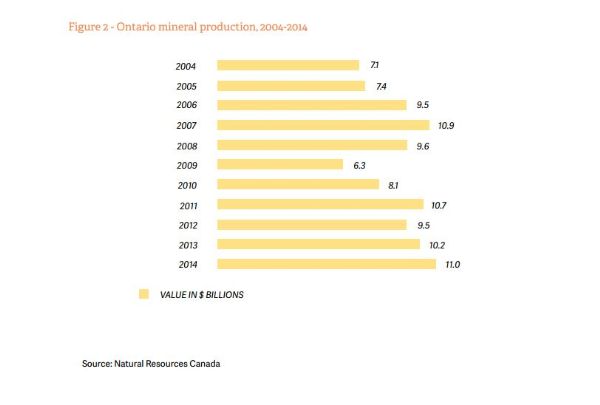THUNDER BAY -- Ontario is the top mining jurisdiction in the country but its business leaders believe the province’s cumbersome regulatory scheme is holding back mining’s potential.
The Ontario Chamber of Commerce released a series of recommendations on Tuesday that it believes would bolster investor certainty in the province’s mining sector, an industry that collectively produced $11 billion worth of minerals in 2014.
The chamber estimates mineral markets will recover in the next year or two. To prepare for that investment surge, it called on the province to boost infrastructure spending in remote areas of Ontario as it standardizes its consultation and revenue sharing with First Nations.
“What we’re hearing from mining companies now is when I talk to this ministry, this is who they tell me to consult with and how I should do it but when I talk to this other ministry, they give me a completely different list of how to do it, who to talk to what the timelines are,” said Charla Robinson, the president of the Thunder Bay Chamber of Commerce.
“Everybody has different rules, different lists, different processes. It makes you want to throw your hands up and say, ‘what am I doing here?'”
The report praises the 1996 Musselwhite Mine Agreement between Ontario and impacted First Nations, which has led to public liaison committees on environmental, social and economic matters as well as 20 per cent of the mine’s employees hailing from those communities.
A document was leaked showing the relationship Ontario hoped to have with Cliffs Natural Resources in developing the Ring of Fire last month. Although Robinson applauded tax relief and energy subsidies contained in that proposal, she insisted Ontario needs to provide uniform support to the industry.
“There are a lot of other mining companies that don’t know what’s being offered to their competitors. You need to have a fair playing field. You need to have certainty so you know this is how the process works,” she said.
“'This is what the government is willing to help with and this is what the governments not willing to help with. This is what the process looks like when you’re dealing with First Nations,' so everyone’s following the same formula. That will also add to that investor confidence. If they feel like maybe they’re not the favourite son, we’re not going to invest in Ontario.”
Minister of Northern Development and Mines Michael Gravelle interpreted the report as a positive reinforcement of his ministry's success under challenging economic circumstances. He pointed out the chamber used the term “powerhouse within Canada” to describe Ontario’s mining industry.

The report’s production graph shows a remarkable rebound in the aftermath of the 2008 recession, despite contending with global economic uncertainty, depressed commodity markets and record Canadian dead capital.
When it comes to Robinson’s concerns over uniformity, Gravelle stood behind the province’s modernized Mining Act, its work to make historic transformations in relationships with First Nations and recent consultations on an updated Mineral Development Strategy, which will be released before the end of 2015.
“For me, I always ask how do you achieve the right balance between maintaining Ontario as a very attractive jurisdiction to the mining sector and at the same time, having a Mining Act with all the right requirements in place that is reflective of 21st Century values?” Gravelle said.
“That’s the balance we try to strike and that’s the what the renewal of our Mineral Development Strategy will try to reflect.”
